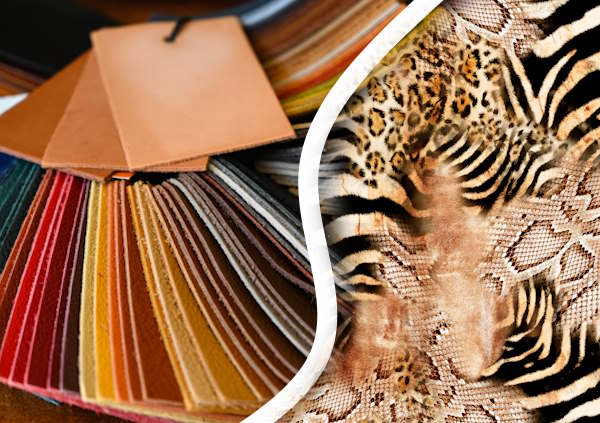Leather has been a coveted material for centuries, known for its durability, versatility, and timeless appeal. Traditionally, leather has been sourced from animals, primarily cows, and has played a significant role in the fashion and manufacturing industries. However, with growing concerns about animal welfare, environmental sustainability, and evolving fashion trends, vegan leather has emerged as a viable alternative. In this blog post, we will delve into the differences and similarities between vegan leather and animal leather, examining materials, pros and cons, expected user experiences, longevity, and their social, economic, and environmental impact.
Materials:
- Vegan Leather: Vegan leather, also known as faux leather or synthetic leather, is a man-made material created using a variety of synthetic and natural substances. Common materials include polyurethane (PU), polyvinyl chloride (PVC), and sustainable options like cork, mushroom leather, or pineapple leather (Piñatex). The production of vegan leather typically involves fewer natural resources compared to animal leather.
- Animal Leather: Animal leather is derived from the hides and skins of animals, most commonly cows, but also from sheep, goats, pigs, and other creatures. The tanning process involves treating these animal hides with chemicals, often posing environmental challenges due to water consumption and pollution.
Pros and Cons:
- Vegan Leather Pros:
- Cruelty-free: Vegan leather doesn’t involve harming animals, making it an ethical choice for animal lovers.
- Versatility: Vegan leather can mimic the texture and appearance of animal leather or even offer unique designs and colors.
- Environmental benefits: Sustainable vegan leather options, like mushroom leather or Piñatex, have a lower environmental footprint compared to traditional leather.
- Vegan Leather Cons:
- Animal Leather Pros:
- Durability: Animal leather is known for its durability and can last for decades with proper care.
- Natural beauty: Many people appreciate the unique texture, patina, and smell of animal leather.
- Biodegradability: Animal leather is biodegradable, which can reduce its environmental impact when properly disposed of.
- Animal Leather Cons:
- Animal welfare concerns: The production of animal leather involves the use of animals, raising ethical questions about their treatment.
- Environmental impact: The tanning process can be environmentally damaging due to chemical use, water consumption, and pollution.
- Limited availability: The demand for animal leather contributes to the livestock industry, which can have negative social and environmental consequences.
User Experience:
- Vegan Leather: Users of vegan leather products can enjoy a guilt-free experience, knowing that no animals were harmed in their production. However, the user experience can vary depending on the quality of the vegan leather, with some synthetic materials being less comfortable or breathable.
- Animal Leather: Those who choose animal leather appreciate its natural look, feel, and longevity. However, some may feel conflicted about the ethical concerns associated with its production.
Longevity:
- Vegan Leather: The longevity of vegan leather depends on the specific material and how well it is cared for. Some high-quality vegan leather products can last for several years, but they may not match the durability of animal leather in the long run.
- Animal Leather: Well-maintained animal leather items can last for decades, and they often develop a desirable patina over time, making them even more valuable and appealing.
Social Impact:
- Vegan Leather: The popularity of vegan leather reflects a growing social consciousness about animal welfare, leading to a shift in consumer preferences away from animal-derived materials.
- Animal Leather: The demand for animal leather has contributed to the livestock industry, raising concerns about animal cruelty, deforestation, and land use.
Economic Impact:
- Vegan Leather: The production of vegan leather supports industries focused on sustainable materials and ethical practices, creating economic opportunities in these sectors.
- Animal Leather: The animal leather industry has historically been economically significant but is facing challenges due to changing consumer preferences and increased scrutiny on environmental and ethical issues.
Environmental Impact:
- Vegan Leather: Some vegan leather options, such as mushroom leather and Piñatex, have a lower environmental impact compared to traditional leather due to reduced resource consumption and chemical use.
- Animal Leather: The tanning process for animal leather can be environmentally damaging, contributing to water pollution and deforestation when sourcing hides.
Similarities:
- Aesthetic Appeal: Both vegan and animal leather offer a wide range of textures, colors, and designs, allowing consumers to choose products that align with their style preferences.
- Versatility: Both types of leather can be used in various applications, including fashion, upholstery, accessories, and automotive interiors.
- Care and Maintenance: Both vegan and animal leather products require proper care and maintenance to maximize their lifespan.
- Market Demand: There is a strong market demand for both vegan and animal leather products, reflecting the diverse preferences of consumers.
Conclusion
In the ongoing debate between vegan leather and animal leather, there are numerous factors to consider. Each type has its own set of advantages and disadvantages, and the choice ultimately depends on individual values, priorities, and preferences. Vegan leather offers a cruelty-free, environmentally conscious alternative, while animal leather boasts unparalleled durability and a timeless appeal. As technology continues to advance, the quality of vegan leather is likely to improve, potentially closing the gap between the two in terms of longevity and comfort. Ultimately, the decision between vegan and animal leather comes down to weighing the ethical, environmental, and personal factors that matter most to you as a consumer.
